This yakisoba is restaurant delicious and easy to make at home – on your table in 30 minutes!
This Yakisoba recipe will cure your cravings for Asian takeout! Yakisoba is a popular Japanese noodle stir fry loaded with crisp-tender veggies and yakisoba noodles in a salty, sweet and savory sauce. This chicken yakisoba boasts the complex flavors of authentic yakisoba but is made with everyday ingredients and easy cooking techniques AKA it’s not authentic but it tastes like it! This yakisoba recipe is filled with yakisoba noodles, juicy chicken, julienned carrots, thinly sliced cabbage, crunchy bell peppers and aromatic garlic, ginger and green onions bathed in a fruity, spicy, sweet and tangy sauce. It is a symphony of tantalizing flavors and textures that’s easy to customize with whatever veggies or protein you have on hand. Add some potstickers and enjoy your own fakeout takeout feast at home!
Asian noodles are always a hit at our dinner table. They’re easy enough for everyday but also super fun to serve (and impress!) company. If you’re also a fan of Asian noodles, you’ll love my Pad Thai, Singapore Noodles, Spicy Korean Noodles, Sesame Noodles, Rice Noodles in Coconut Curry Sauce, and Thai Pumpkin Pasta.
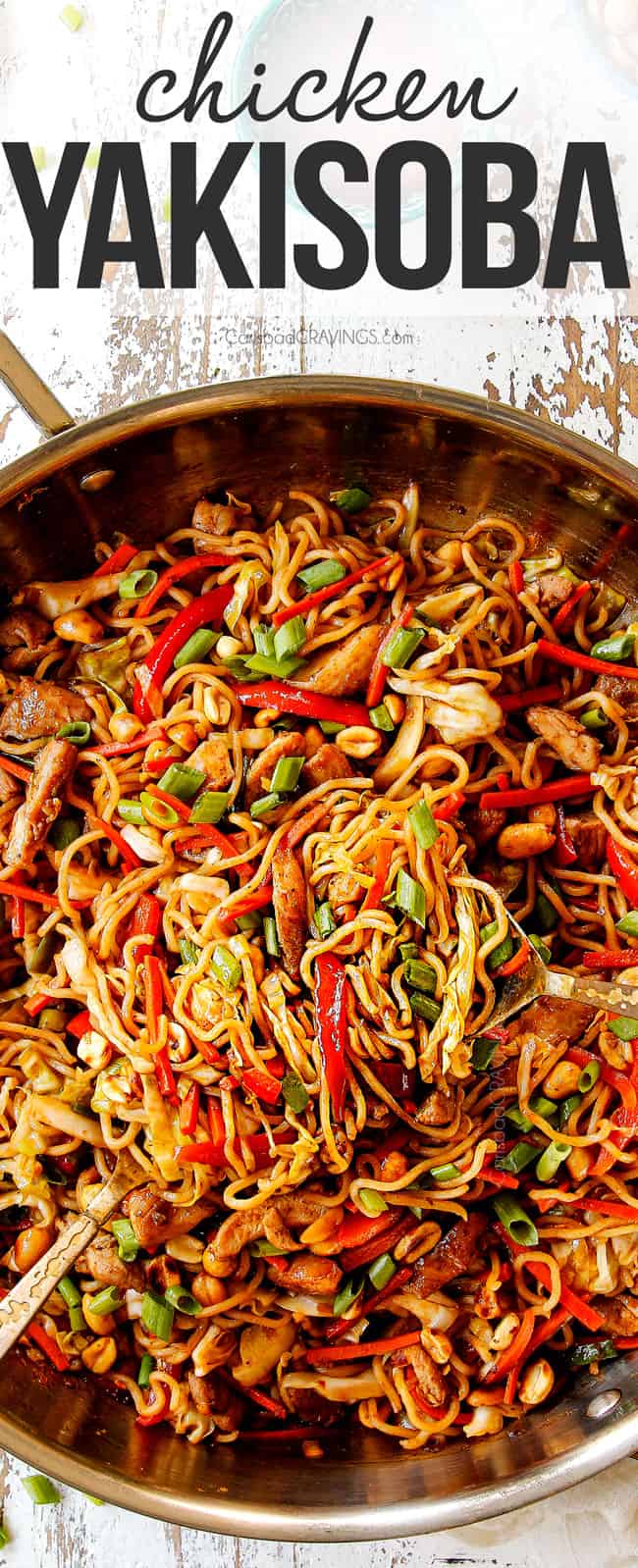
PIN THIS RECIPE TO SAVE FOR LATER
YAKISOBA RECIPE
This chicken yakisoba is about to become one of your go-to easy dinner recipes that is 5-star spectacular! For this yakisoba recipe, I wanted to create a dish that would be quick and easy but still unabashedly flavorful made with pantry friendly ingredients.
To that end, I chose to use chicken as opposed to pork, amped up the garlic and ginger and created my own yakisoba sauce made with pantry stables (if you do much Asian cooking). The resultant recipe boasts complex layers of sweet, tangy, savory, garlicy, gingery and as-spicy-as-you-want-it sauce and a stir fry that is easy to adapt with what you have on hand.
IN SUMMARY, HERE’S WHILE YOU’LL LOVE THIS YAKISOBA RECIPE:
- The best recipe! Many yakisoba recipes deliver soggy yakisoba – not this recipe! I use simple techniques to create restaurant quality yakisoba every time.
- Versatile. Use pork, chicken, ground pork, beef or shrimp! You can also add whatever veggies you have on hand. If you don’t have yakisoba noodles, you can use ramen, udon or even spaghetti!
- Family friendly. Everyone loves yakisoba! Unlike my spicy Korean Noodles, yakisoba is not meant to be overly spicy – or only as spicy as you want to make it.
- Easy. Please don’t shy away when you look at the ingredient list – it is a little lengthy – but most of the ingredients are just dump and whisk; I wouldn’t want you to cheat yourself out of this yakisoba recipe! To make, you’ll whisk the sauce together, cook the chicken, stir fry the veggies then add the sauce and noodles – easy peasy!
- Simple ingredients. This yakisoba recipe is made with pantry staples if you do much Asian cooking at all. If not, you can easily find all of the ingredients at your grocery store.
- Prep ahead. The fantastic thing about this yakisoba recipe is how much you can prep ahead yet it still tastes 100% fresh thanks to the quick stir fry. You can make your sauce, chop your veggies and even cook your chicken ahead of time so come go-time, you’re literally 10 minutes away from dinner!
I’m going to go into depth about what yakisoba is, how to make, tips and trick and hopefully answer all your questions so you can read on or use my “jump to recipe” button at the top of the page to skip straight to the recipe.
WHAT IS YAKISOBA?
Before we jump into this incredible yakisoba recipe, what exactly is it? Yakisoba is appropriately named as it translates to “fried noodle” in Japanese: 焼きそば [jakiꜜsoba]), yaki = grilled/fried and Soba = noodles. Yakisoba is a Japanese noodle stir fry made with stir fried wheat flour noodles, chopped pork belly, and vegetables such as cabbage, carrots, sprouts and onions, tossed in a tangy, sweet and sour sauce primarily flavored with Japanese Worcestershire sauce, soy sauce, oyster sauce, salt and pepper.
Although yakisoba is one of Japan’s most well-known street foods, it is a relatively newer Japanese invention, appearing in Japan in the early 20th century. Today, yakisoba can be found in food stalls everywhere from festivals, to sporting events, to concerts.
How to serve yakisoba?
Yakisoba in the states is served piled on a plate but in Japan, it often takes the form of Yakisoba-pan, in which the noodles are piled into a sliced bun (much like a hot dog) then piled with all sorts of toppings such as Japanese-style mayonnaise, pickled ginger, aonori (seaweed powder) and bonito. These toppings are often served alongside the plated version as well – just minus the bun.
Interesting History of Yakisoba
After world war II, the US military supplied American food products to devastated Okinawa. The Japanese used these American products such as spaghetti, spam, ketchup, canned vegetables and mayonnaise to prepare their beloved yakisoba. Today, the legacy lives on. In Okinawa, yakisoba noodles are often served with chopped fried spam, hot dogs, and ham.
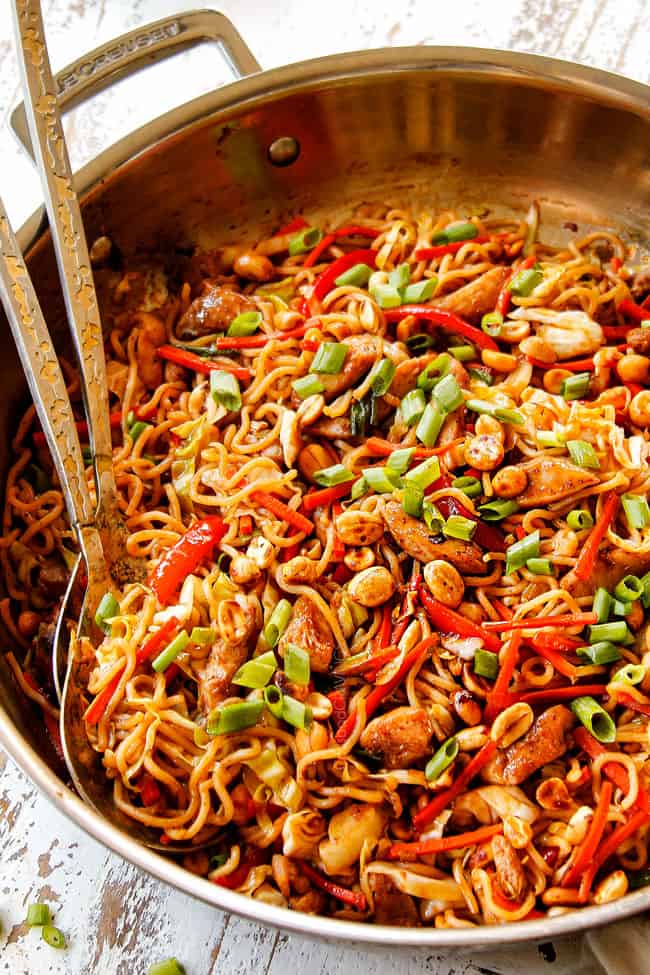
WHAT ARE YAKISOBA NOODLES MADE OUT OF?
Yakisoba noodles are called Mushi Chukamen (蒸し中華麺 or Steamed Chinese-style noodles). Despite their name, yakisoba noodles are not made of buckwheat (most people outside of Japan associate soba with buckwheat noodles). Instead, the soba in yakisoba means Chinese noodles (Chuuka soba). Historically, soba was used to refer to any long, thin noodle.
Yakisoba are made with wheat flour, water and kansui (かん水). Kansui is a salty, alkaline liquid that gives the noodles their chewy, springy texture which makes them look like egg noodles, minus the egg. Fresh yakisoba noodles are steamed and packaged, so they’re pretty much cooked and just need a quick reheat. You will also find yakisoba that is fried and dried.
Are yakisoba noodles the same as ramen noodles?
The texture of yakisoba noodles is similar to ramen noodles but the ingredient proportions vary slightly to produce slightly different noodles. Also, the majority of the yakisoba wheat noodles in Japan are steamed and coated with oil, unlike ramen.
Where to Buy Yakisoba Noodles
Yakisoba noodles have increased in popularity so you should be able to find them in most grocery stores. Look for yakisoba noodles in the refrigerated produce section near the tofu and egg roll wrappers. Some of the most popular yakisoba noodle brands in the US are Fortune, Myojoa and Maruchan. They come with three packets of yakisoba noodles in each package that have been steamed, coated with oil, and vacuum-sealed. We will use two of those packets for this yakisoba recipe.
The yakisoba noodles will also come with sodium, msg-filled seasoning packets that you can discard. Other brands can also come packaged with water which you will want to drain off before using.
If you are having a hard time locating yakisoba noodles, you will definitely be able to find them at Japanese, Korean or Chinese grocery stores or you can order them on Amazon here.
Yakisoba noodles also come pre-fried and dried in packages much like instant ramen. If you are in a bind, you can use those as well, just discard the seasoning packet and cook according to package directions but the texture won’t be quite the same.
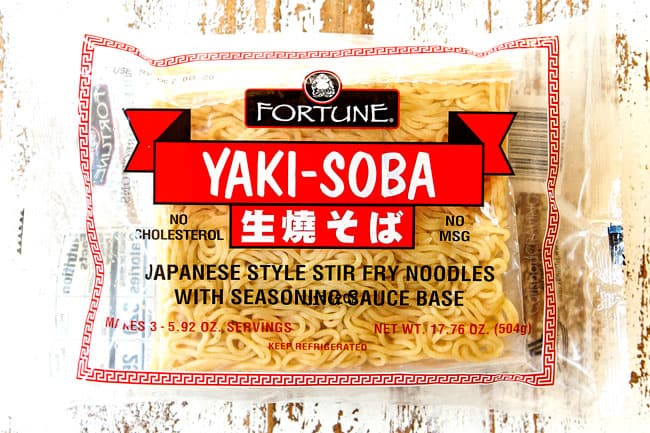
CAN I USE DIFFERENT NOODLES?
Ramen noodles are the most similar to yakisoba noodles and are a great substitute. If you can get your hands-on fresh ramen, use that, or even fresh chow mein; otherwise instant/dried ramen noodles are super easy to find at your local grocery store. When using instant ramen noodles, discard the seasoning packet and only use the noodles. You will need to cook according to package directions before using in the recipe – but don’t overcook!
You can also find dried ramen in the Asian section of many grocery stores or at most Asian markets without the seasoning packet. I prefer NongShim Shin Ramyun ramen packets or Samyang ramen packets. They are thicker and heartier which means they stay nice and firm for longer.
Pantry friendly Yakisoba
You can also use spaghetti in a pinch. Cook according to package directions just until al dente.
HOW DO I COOK YAKISOBA NOODLES?
Yakisoba noodles come already steamed, so they don’t require cooking, just reheating to warm through and to loosen the noodles so they no longer stick to each other. I recommend following the instructions on your packaging. This will either have you:
- Option 1: Transfer the yakisoba noodles to a sieve and run hot water over the noodles, separating the noodles with your hands.
- Option 2: Pour boiling water directly into the package of noodles (or transfer to a bowl). Loosen the noodles with chopsticks and drain in a colander.
- Option 3: Add noodles to a pot of boiling hot water and separate with chopsticks for up to 1 minute. Drain in a colander.
- Option 4: Puncture noodle pouch and microwave on high for 1 minute.
Option 4 is super easy but not effective for all brands. If your specific package recommends this method, then it should work fine, otherwise, I find option 3 the very easiest and most effective for all brands. You will want to take care to not over-cook the noodles as they will continue to cook in the sauce. Add them to the water just long enough to separate the noodles from each other.
How do I prevent yakisoba noodles form sticking together?
After you separate the yakisoba noodles, rinse them in cold water so they don’t continue to cook then toss with 2 teaspoons sesame oil. Toasted sesame oil is a “secret ingredient” that adds an irresistible, subtle nutty flavor and will prevent the noodles from sticking together – or sticking to the pan.
WHAT IS YAKISOBA SAUCE MADE OF?
Yakisoba sauce makes the dish, otherwise it’s just noodles and veggies. Yakisoba sauce is salty, sweet, sour, spicy, and deeply satisfying as it envelops every nook and cranny of the stir-fried noodles.
In authentic yakisoba, the main ingredient of the sauce is chūno sōsu, a popular Japanese condiment used as a marinade, salad dressing and dip. It is fruity, spicy, sweet and vinegary, very similar to our Worcestershire sauce.
Chūno sōsu isn’t a pantry friendly item in the US, so this yakisoba recipe combines Worcestershire sauce, ketchup, brown sugar, soy sauce, oyster sauce, hoisin sauce and chili sauce. The Worcestershire mimics the tangy chūno sōsu, the ketchup and brown sugar amp up the fruity sweetness, the soy sauce adds the saltiness, and the oyster sauce and hoisin add a rich umami flavor. I also add Asian chili sauce to round out the flavor profile because we like things spicy around here – but you can omit it altogether if you like.
The yakisoba sauce can be whisked together in minutes, stored for weeks, then just thrown into the skillet when you’re ready to cook! Here’s what you’ll need:
YAKISOBA SAUCE INGREDIENTS:
- Worcestershire sauce: adds a depth of complex umami, slightly tangy flavor.
- Soy sauce: use reduced sodium soy sauce or your yakisoba will be too salty.
- Ketchup: might sound like an odd ingredient but is fairly common in Chinese-American dishes such as Sesame Chicken. I promise you won’t be able to detect the ketchup!
- Oyster sauce: adds that extra punch of flavor that takeout sauces have and will elevate your yakisoba to new heights. Oyster sauce is a thick, brown sauce with a balance between sweet and salty with an earthy undertone, due to the oyster extracts. You can find oyster sauce in the Asian aisle of any supermarket for only a few dollars. Please use QUALITY oyster sauce such as Lee Kum Kee or Kikkoman. You truly can taste the difference and will be sorely disappointed with less quality brands.
- Hoisin sauce: can be found in the Asian section of any grocery store. It tastes like a sweet, salty and tangy, thick Asian BBQ Sauce. Please use only quality hoisin sauce like Lee Kum Kee or Kikkoman as all hoisin sauces are not created equal – you truly can taste the difference. I use hoisin sauce all the time in my Asian recipes such as Kung Pao Shrimp, Mongolian Chicken, Orange Chicken, etc., so I promise it will not go to waste!
- Brown sugar: use light packed brown sugar.
- Asian chili sauce: if you feel like your Yakisoba is missing something, it is probably heat! I recommend adding more to taste at the end of cooking if you would like it spicier. I use Sambal Oelek with the green lid but you can also use your favorite chili sauce and adjust accordingly.
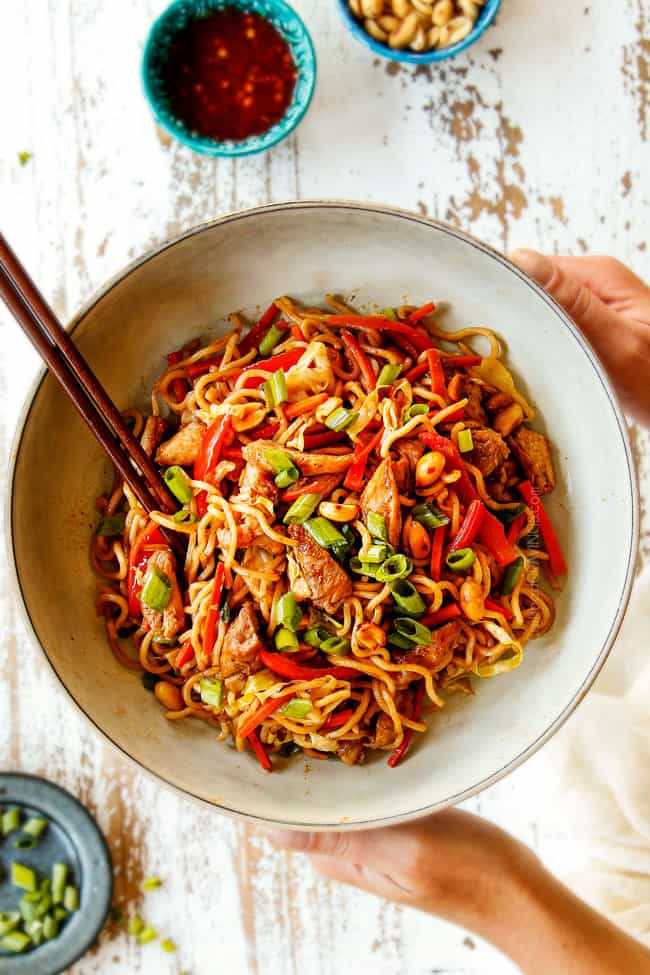
What if I’m allergic to shellfish?
If you’re allergic to shellfish, use LEE KUM KEE Vegetarian Stir-Fry Sauce instead of oyster sauce.
HOW DO I STORE YAKISOBA SAUCE?
Yakisoba sauce can be made ahead of time and stored in an airtight container or mason jar in the refrigerator for up to two weeks. Give it a quick whisk it to recombine before using.
HOW DO I MAKE THE BEST YAKISOBA SAUCE?
It’s important to taste the sauce so it can be adjusted to your personal preferences, especially because not all products are created equal. Some ketchup, for example, is sweeter than others, while some Worcestershire sauce is tangier than others. Just keep a note of your adjustments then whip out the perfect sauce every time. Here’s how:
- for extra tang, add Worcestershire sauce
- for more fruity sweetness, add ketchup
- for more sweetness, add additional brown sugar
- spice it up with Asian chili paste
- add salt with additional soy sauce
- amp up the garlic and/or ginger for a stronger punch of flavor
What meat to use for yakisoba?
Yakisoba is most commonly made with thinly sliced pork belly; however, it is delicious with ground pork, chicken, shrimp, steak or tofu. You can even omit the meat altogether and make vegetarian yakisoba.
For this chicken yakisoba recipe, you can use boneless chicken thighs or chicken breasts although I prefer chicken thighs hands down and HIGHLY encourage you to use them. Chicken thighs are juicier, more tender, and richer tasting and don’t dry out when cooked at high heat. Chicken thighs are also hard to overcook which means your leftovers are just as tasty when reheated.
I reserve chicken breasts for Asian recipes that utilize the Chinese velveting technique or a marinade to promote juicier chicken breasts.
How to make chicken breasts tender
If you still want use chicken breasts, you may want to consider velveting the chicken first. It is one extra step (which using chicken thighs saves you) but it is quick and easy and is how Chinese restaurants attain such smooth, tender chicken.
To velvet chicken breasts, add the following to a large freezer bag or bowl and whisk to combine:
- 1 tablespoon cornstarch
- 1 tablespoon reduced sodium soy sauce
- 1 tablespoon toasted sesame oil
- 1 teaspoon Japanese rice wine (like Kikkoman Aji Mirin)
- 1 teaspoon baking soda
Add the chicken and turn until evenly coated. Let sit at room temperature while you prep your veggies; preferable 30 minutes (no more).
If you velvet the chicken, you will need to use more oil for cooking if using a stainless-steel pan so the chicken doesn’t stick or use cast iron skillet instead.
Can I Use Pre-cooked Chicken for This Recipe?
If you want an easy shortcut, use whatever leftover chicken you have on hand, chopped into bite size pieces. You can also use a rotisserie chicken. I love rotisserie chicken because it is both light and dark meat and delicately seasoned. Add whatever cooked chicken you choose in with the sauce just so it has time to warm through.
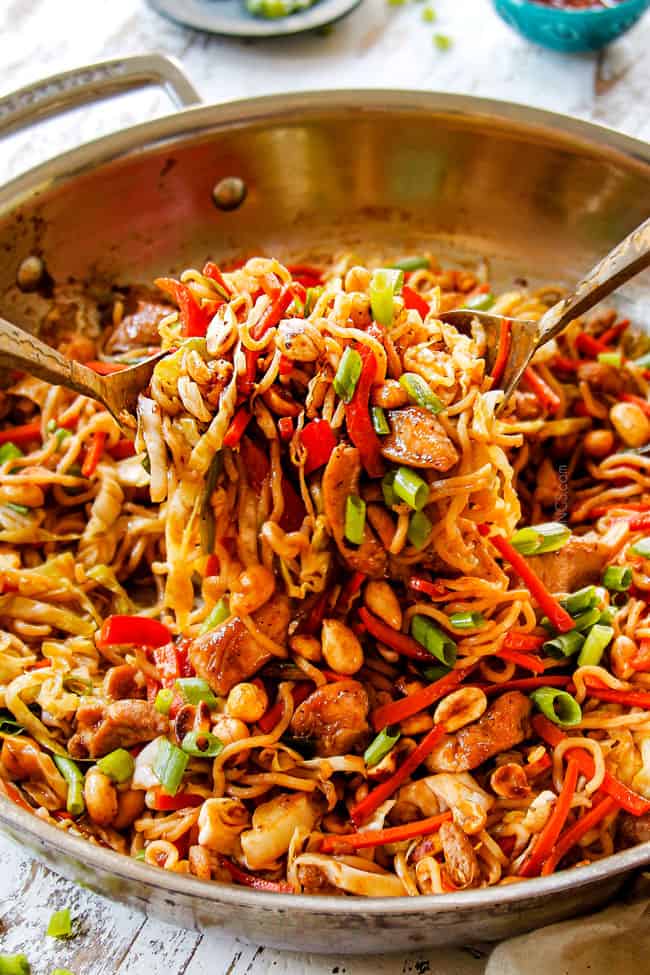
WHAT VEGGIES GO IN YAKISOBA?
Yakisoba is known for its trinity of cabbage, carrots, and onions, but you can mix and match your veggies based on what’s in your fridge, your favorites, what’s in season or what’s on sale. If you follow the recipe, this is what you’ll need:
- Oil: use a neutral oil for cooking such as vegetable oil or canola oil.
- Bell pepper: 1 red bell pepper or you may substitute with orange or yellow. I wouldn’t go green though as green bell peppers aren’t as sweet.
- Carrots: you will need 1 large carrot cut into matchsticks. If you purchase matchstick carrots, they are thinner so they won’t require as long of cooking time.
- Green cabbage: you may substitute with purple cabbage as well but I wouldn’t use savoy cabbage as it doesn’t hold up as well.
- Green onions: we will use all of the green onions – both the white parts and green parts at different times in cooking, so just separate them once chopped. I consider the “white parts” up to where they are noticeably green and beautiful for garnish. One green onion may include 2-3 green stalks – use all of it.
- Ginger and Garlic: add warm spicy, almost pepper taste. These aromatics awaken and elevate the entire yakisoba recipe. If you’re looking to save time and skip some chopping or you don’t have fresh aromatics on hand, you can substitute the fresh garlic and ginger with powders and add them directly to the sauce. The typical rule of thumb is 3:1, so one part dried to three parts fresh.
Vegetable shortcuts
Pick up a bag of your favorite stir-fry veggies or swap the cabbage and carrots with a bag of pre-shredded coleslaw mix.
CAN I USE DIFFERENT VEGETABLES?
Yakisoba makes a FABULOUS clean-out-the veggie drawer meal. You can use pretty much any vegetable such as:
- Broccoli
- Mushrooms
- Snow Peas
- Zucchini
- Celery
- Asparagus
- Baby corn
- Edamame
- Bean sprouts
- Spinach
- Bok choy
How do you garnish yakisoba?
Yakisoba is traditionally topped with beni shoga (red picked ginger), aonori (green seaweed powder), katsuobushi (bonito flakes) and Japanese mayonnaise. The pickled ginger adds a tangy punch and the bonito and aonori add an intensely savory, slightly fishy flavor that balance the pickled ginger. These toppings will amp up your already delicious yakisoba but are completely optional. I just use green onions ;).
RECIPE VARIATIONS
This yakisoba recipe is all about making it YOURS using the sauce as the scrumptious base. You can swap the protein, swap the veggies and even swap the noodles. Here are some ideas to mix it up:
- Swap protein: use anything! Thinly sliced pork belly, thick cut bacon, ground pork, ground beef, ground turkey or shrimp. If you use pork belly or bacon, you will want to omit the salt because pork, especially bacon, is quite salty.
- Tofu: you can go vegetarian by omitting the protein altogether or using tofu in its place. You will want to use firm tofu. To prep the tofu, place it in a pie plate, top with a heavy plate and weigh down with 2 heavy cans (to release water). Set aside for 10 minutes while you finish prepping the veggies.
- Swap vegetables: add anything you have on hand, just take care you don’t overcook the vegetables. You’ll want to cook longer cooking vegetables like broccoli before adding short cooking vegetables like zucchini and snow peas.
- Nuts: not traditional, but I LOVE adding peanuts to my yakisoba. They add a deeply satisfying crunch that you will CRAVE in every bite! Take care to purchase raw, unsalted nuts; you can find them at the bulk bins at Sprouts. To elevate your nuts, dry roast them in a skillet until toasted- YUM!
- Water chestnuts: also add a tantalizing crunch. Water chestnuts are easy to find in a can so you can keep them stocked and ready to go.
- Canned bamboo Shoots: should be easy to find at every grocery store. They add a crunchy, meaty texture.
- Sesame seeds: add the nutty sesame flavor. Take care to use toasted sesame seeds or toast them yourself.
- Make it spicy: this yakisoba recipe calls for 2-3 teaspoons Asian chili sauce but add as much as you like to feel the heat!
What pan to cook YbAKISOBA?
Yakisoba is traditionally made on a teppan, a large iron griddle, which allows all of the ingredients constant contact to the sizzling surface. This not only cooks the ingredients quickly and evenly but chars them up a bit for fantastic smokey flavor.
Instead of a teppan, use a large pan with a heavy bottom that’s large enough to comfortably hold all of your ingredients, including the yakisoba noodles. Both a large stainless steel pan and cast-iron pan will work well. They provide enough surface area to stir fry the ingredients and retain constant heat.
I love my stainless steel saucepan as it’s virtually indestructible, distributes heat evenly, and won’t leech into the food. It is particularly useful when cooking with acidic ingredients like tomatoes, vinegars, lemon or lime juice because the metal won’t react with the acidity. I love both my 10 and 12-inch Le Creuset Stainless Steel Pans and used my 12-inch for this yakisoba recipe. This more economical pan also has excellent reviews.
A quick note, if you choose to use velveted chicken breasts (as opposed to thighs) and a stainless-steel pan, you will need to use plenty of oil so the chicken doesn’t stick.
How to Make Yakisoba
Step 1: Prep Noodles
- The noodles are already steamed, so our main goal is to separate them. The easiest way to do this is to add the noodles to a large pot of boiling hot water then stir with a chopstick to break up the noodles.
- Stir for 1 minute or less, just until the noodles are separated – don’t overcook!
- Transfer to a colander and rinse with cold water.
- Drain thoroughly then drizzle with sesame oil to prevent the noodles from sticking together; set aside.
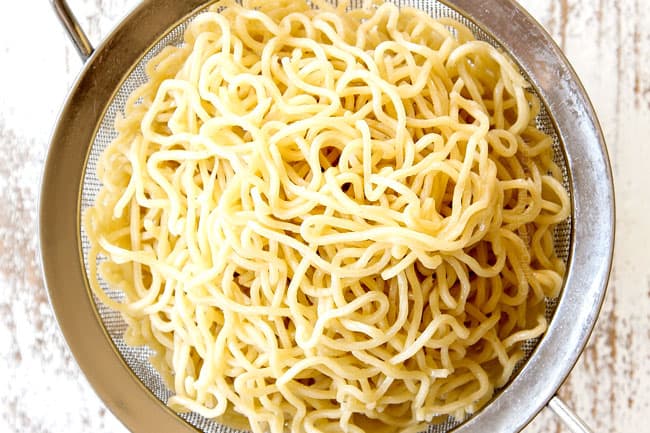
Step 2: Stir Fry Noodles
- Many recipes don’t stir fry the noodles first, but this is a game changer. Stir frying the noodles creates authentic tasting NON- SOGGY noodles.
- Heat 1 tablespoon vegetable oil over medium-high heat in a large wok or heavy bottom skillet/saucepan with deep sides (stainless steel or cast iron). Add the well-drained noodles to the pan and stir fry 2 minutes, transfer to a plate.
Step 3: Make sauce
- You can make the sauce while you’re waiting for the water to boil.
- In small bowl, whisk together Worcestershire sauce, soy sauce, ketchup, oyster sauce, hoisin sauce, brown sugar and Asian chili sauce; set aside.
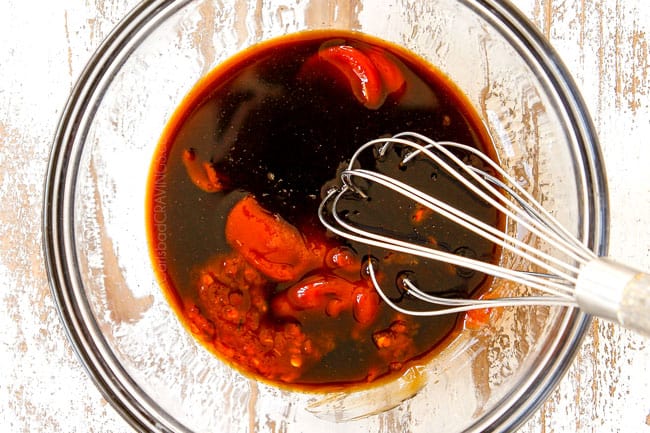
Step 4: Cook bchicken
- It is important to cook the chicken first because as it browns in the skillet, it creates a layer of flavor that will be scooped up by the veggies.
- While chicken is still on the cutting board, pat dry and season with salt, pepper and paprika.
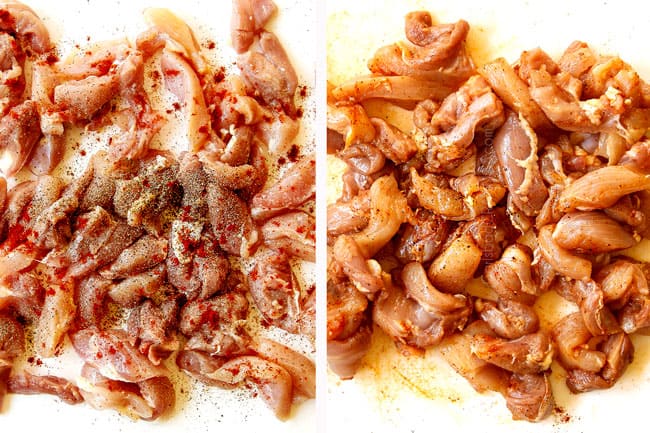
- Add chicken to a heavy-duty pan and let sear for a couple minutes, then continue to cook and stir until cooked through, about 5 minutes. Transfer to a plate.
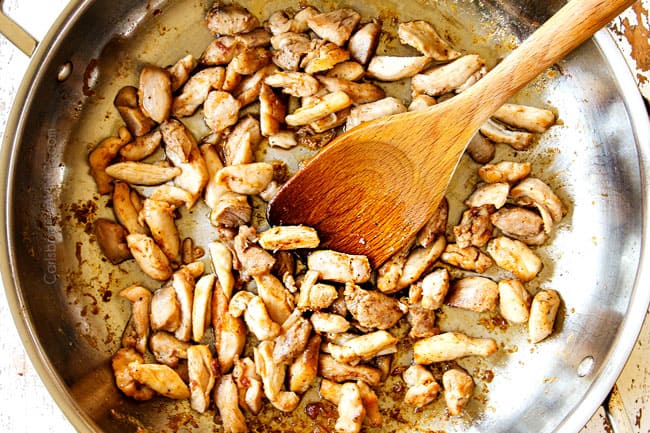
Step 5: Cook Veggies
- After you remove the chicken, don’t wipe out the skillet, we want all those brown bits to flavor the veggies.
- Add an additional 1 tablespoon vegetable oil to the skillet.
- Once hot, add bell peppers, carrots and white parts of the green onions and stir fry one minute. Add garlic and ginger and stir-fry 30 seconds.
- Add the cabbage and green parts of green onion and sauté until cabbage begins to wilt, approx. 1 – 2 minutes.
- DON’T over-cook because the cabbage will continue to cook in the sauce – it’s better to have crunchier cabbage than soggy cabbage in my opinion.
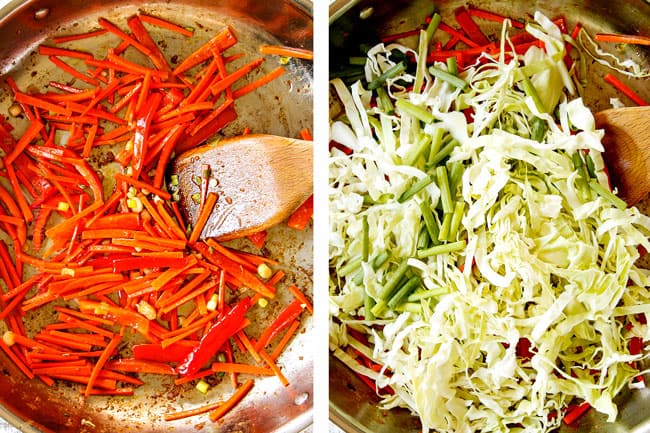
Step 6: Combine
- Add the chicken, peanuts and sauce to the skillet and stir to combine.
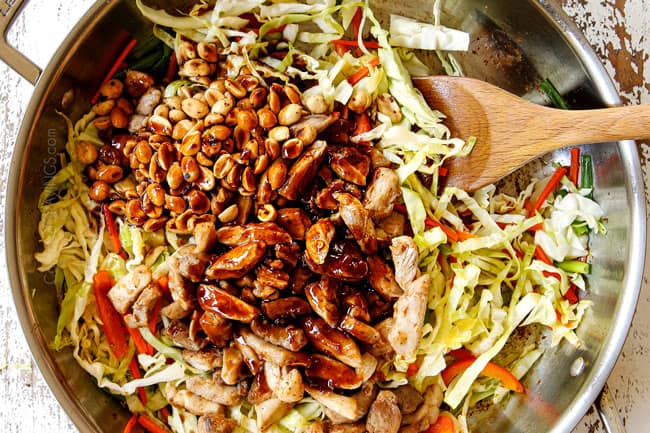
- Increase heat to high and add noodles. Cook just until warmed through, approx. 1 minute.
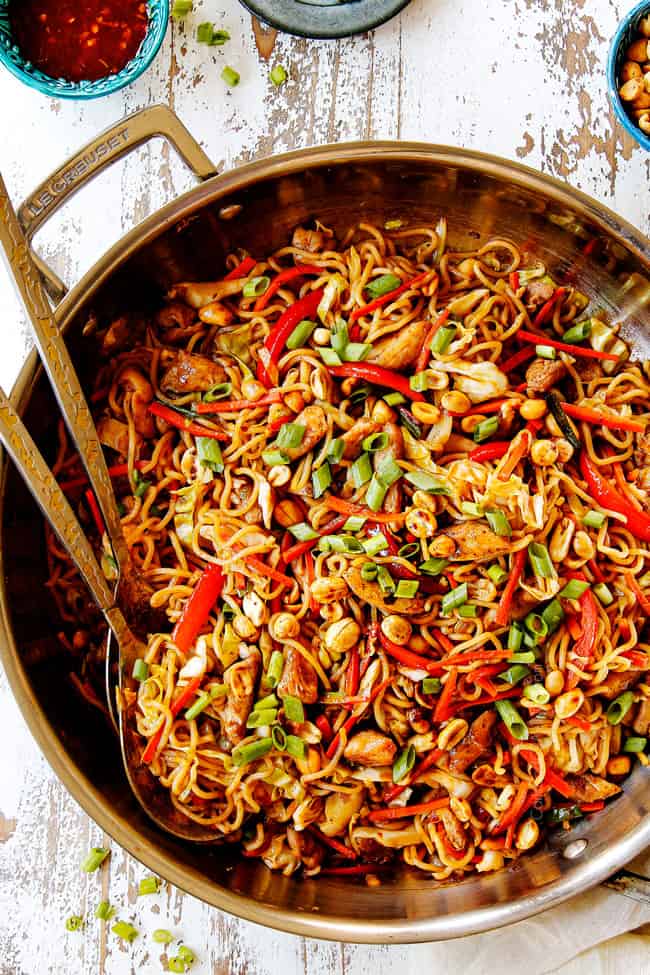
Tips for the Best Yakisoba Recipe
This yakisoba recipe is pretty straight forward, but there some simple techniques, tips and tricks for the best yakisoba every time.
- Use a large heavy bottom pan. Use a large stainless-steel saucepan or cast-iron skillet to provide enough surface area to stir fry the ingredients and retain constant heat so the ingredients stir fry and don’t just steam.
- Separate the noodles but don’t overcook. Loosen the noodles in boiling hot water for up to 1 minute, just until the noodles are separated – don’t leave them the water too long or they can become too soft.
- Prevent noodles from sticking. Rinse and drain the noodles very well so they don’t become soggy then drizzle with sesame oil to prevent them from sticking together. If you don’t have sesame oil, use another neutral oil such as canola or vegetable oil.
- Stir fry the yakisoba noodles first. I have made this yakisoba recipe with and without stir frying the noodles first so I can attest it is WAY better if you stir fry the noodles first. Stir frying the noodles releases the excess moisture so they are no longer water-logged and creates a protective exterior so they remain al dente instead of becoming mushy when combined with the sauce.
- Use correct oil. You may substitute the vegetable oil with peanut oil but please don’t use olive oil because olive oil has a lower smoking point and stronger flavor.
- Use QUALITY ingredients. Use high quality oyster sauce and hoisin sauce like Lee Kum Kee or Kikkoman because you literally can TASTE the difference! Poor quality hoisin and oyster sauce can ruin your entire yakisoba.
- Customize veggies. You can substitute the veggies for your favorites. Make sure to cook longer cooking vegetables first then add the short cooking vegetables.
- Carrots. If you don’t cut your own matchstick carrots, then store-bought matchstick carrots will be much thinner. Add store-bought matchstick carrots to the skillet with the cabbage and NOT the bell peppers.
- Ginger pro tip: I like to freeze ginger so it’s always at my fingertips. To freeze ginger: grate it, spread it by the teaspoon or tablespoon on parchment paper and flash freeze until solid, about 1 hour. Transfer to an airtight container or plastic bag for up to 6 months. You can add frozen ginger directly to your stir fry.
- Prep veggies and sauce first. You want the sauce and the veggies all prepped before you start cooking because the stir fry literally takes minutes. If you have to stop to make your sauce while your veggies are still in the pan, they can end up soft and even worse – mushy. The goal is to keep a hot pan the entire time.
- Don’t overcook chicken. For the juiciest chicken, don’t overcook! It takes less time to cook than you might think. The chicken is also less hard to overcook if you don’t cut it too small.
- Don’t overcook veggies. I suggest setting the timer while cooking for the veggies. It is better to under-cook them so they’re crisp-tender rather than tender-crisp.
- Don’t overcook the yakisoba. This dish only needs to cook a minute or so once you add the noodles. Don’t stir fry too long after add the noodles or they can become soggy.
- Cook noodles at thigh heat. To that end, cook the noodles with the sauce on high heat so the noodles and sauce can cook as quickly as possible and not become soggy.
- Customize heat. If you feel like your yakisoba is missing something, it is probably heat! Add additional chili sauce to taste. You may also need to season with additional salt.
- Add peanuts. This is optional and not authentic but I love the additional nutty crunch. To add peanuts, dry roast ½ cup unsalted peanuts by toasting them in the same skillet over medium-high heat without oil, stirring occasionally, until golden in spots.
HOW TO PREP Yakisoba AHEAD OF TIME
Chicken yakisoba comes together quickly, still it can be helpful to prep ahead so dinner can be on the table in 15 minutes! Here’s how:
- Chicken: chop and season the chicken then store in an airtight container in the refrigerator for up to 24 hours.
- Sauce: whisk the sauce ingredients together up to 2 weeks in advance and store, covered in the refrigerator. Let the sauce sit at room temperature for 30 minutes or so before using. You may also freeze for up to three months.
- Veggies: slice the cabbage, chop the bell pepper, julienne the carrots, grate the ginger and mince the garlic 24 hours in advance and store in separate air tight containers in the refrigerator.
WHAT SHOULD I SERVE WITH YAKISOBA?
This chicken yakisoba is explosively flavorful bursting with protein, veggies and carbs so it’s a complete meal-in one! To turn it into a complete Asian feast, pair it with:
- Appetizers: not all of these appetizers are Japanese, but they are all SO tasty! We love yakisoba with Potstickers, Crab Rangoons, Chicken Lettuce Wraps, Pineapple Cream Cheese Wontons, Traditional Egg Rolls, Sesame Chicken Egg Rolls, Sweet and Sour Chicken Egg Rolls or Chinese Chicken Wings.
- Salad: some of our favorite Asian inspired salads include Crunchy Asian Salad, Chinese Salad, and Asian Pineapple Salad.
- Soups: Asian soups make a fantastic starter such as Wonton Soup, Egg Drop Soup or Miso Soup.
- Fruit: fresh fruit such as chopped pineapple is always an easy, welcome sweet stir fry side. Grilled Pineapple, Summer Fruit Salad, Perfect Fruit Salad, Creamy Grape Salad, and Pina Colada Fruit Salad are also fantastic.
HOW TO bSTORE YAKISOBA
This yakisoba reheats wonderfully for lunches or dinners, just take care to not overcook the noodles initially.
- How to store: store leftovers in an airtight container in the refrigerator for up to 5 days.
- How to reheat in microwave: transfer small portions to a microwave safe dish, heat for one minute, stir then continue to heat at 30 second intervals.
- How to reheat on the stove: for larger portions, rewarm in a large skillet, over medium-high heat stirring often.
CAN I FREEZE YAKISOBA?
I do not recommend freezing the yakisoba recipe once assembled because the noodles can become an unpleasant texture but you may freeze the chicken and stir fry sauce separately:
- Sauce: whisk together, add to a freezer bag or freezer safe airtight container, label and freeze for up to 3 months.
- Chicken: let cooked chicken cool completely then transfer to an airtight container or plastic freezer bag and squeeze out any excess air. Freeze for 2 to 3 months.
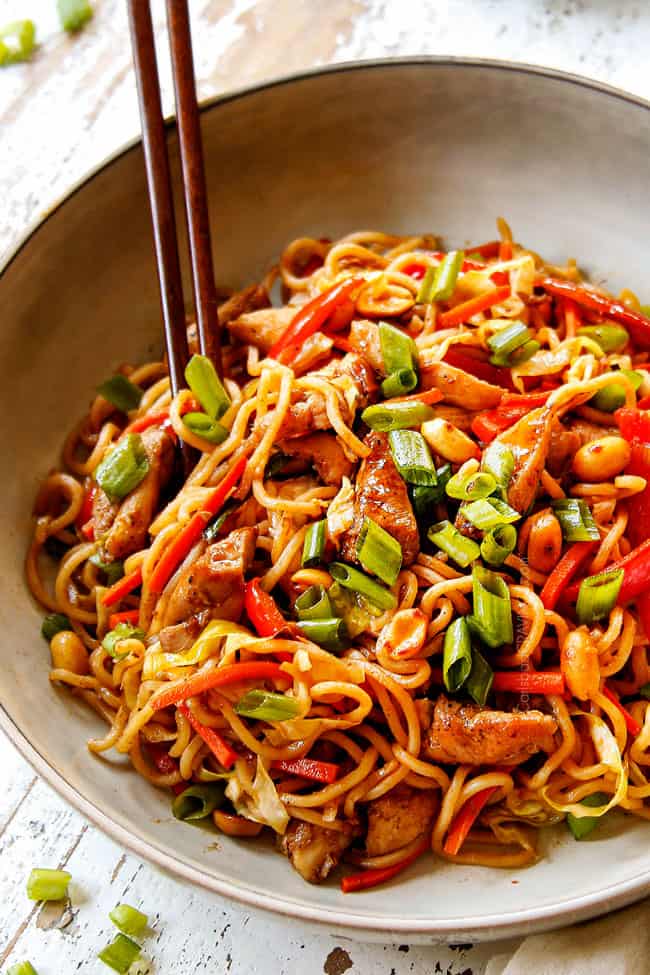
Want to try this Yakisoba RECIPE?
Pin it to your Asian, Noodles, Dinner or Chicken Board to SAVE for later!
Find me on Pinterest for more great recipes! I am always pinning :)!
©Carlsbad Cravings by CarlsbadCravings.com
Tools Used in This Recipe
See Favorite Tools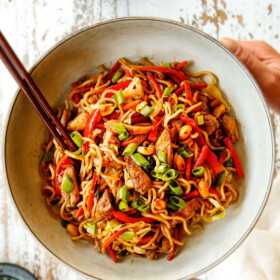
Chicken Yakisoba
Save This Recipe To Your Recipe Box
You can now create an account on our site and save your favorite recipes all in one place!
Ingredients
Sauce
- 1/4 cup Worcestershire sauce
- 2 tablespoons reduced sodium soy sauce
- 2 tablespoons ketchup
- 1 tablespoon oyster sauce
- 1 tablespoon hoisin sauce
- 1 1/2 tablespoons brown sugar
- 2-3 teaspoons Asian chili sauce
Stir-Fry
- 2 5.9 oz. pks. refrigerated yakisoba noodles (seasoning packets discarded)*
- 2 teaspoons toasted sesame oil
- vegetable oil or other neutral oil
- 1 lb. chicken thighs sliced into 1-inch wide, 2” long pieces
- 1/4 tsp EACH salt, pepper, paprika
- 1 red bell pepper sliced into strips, then halved
- 1 large carrot cut into matchsticks
- 2 green onions white parts chopped 1/4”-inch long, green parts chopped 1-inch long
- 1 tablespoon freshly grated ginger
- 3-4 cloves garlic minced
- 4 cups thinly sliced green cabbage
Instructions
- Bring a large pot of water to a boil. Meanwhile, prep your veggies. Once boiling, turn off heat and add the noodles. Stir the noodles with a chopstick to loosen the noodles for up to 1 minute (no more), just until the noodles are separated – don’t overcook! Transfer to a colander and rinse with cold water. Drain VERY WELL then drizzle with sesame oil to prevent the noodles from sticking together; set aside.
- Heat 1 tablespoon vegetable oil over medium-high heat in a large wok or heavy bottom skillet/saucepan with deep sides (stainless steel or cast iron). Once very hot, add the well-drained noodles to the pan and stir fry 2 minutes, transfer to a plate.
- In a small bowl, whisk the sauce ingredients together; set aside.
- While the chicken is still on the cutting board, pat dry and season with salt, pepper and paprika.
- Heat 2 tablespoons vegetable oil over medium-high heat to the now empty skillet. Add chicken and let sear for a couple minutes, then continue to cook and stir until cooked through, about 5 minutes. Transfer to a plate; don’t wipe out skillet.
- Add an additional 1 tablespoon vegetable oil to the skillet. Once hot, add bell peppers, carrots and white parts of the green onions and stir fry one minute. Add garlic and ginger and stir-fry 30 seconds. Add the cabbage and green parts of green onion and sauté until cabbage begins to wilt, approx. 1 – 2 minutes.
- Add the chicken,and sauce to the skillet and stir to combine.
- Increase heat to high and add noodles. Cook just until warmed through, approximately 1 minute then remove from heat. Garnish with additional green onions if desired. and season with salt, pepper and/or Asian chili saute to taste. Serve immediately.
Notes
WHERE TO BUY YAKISOBA NOODLES
Yakisoba noodles have increased in popularity so you should be able to find them in most grocery stores. Look for yakisoba noodles in the refrigerated produce section near the tofu and egg roll wrappers. If you are having a hard time locating yakisoba noodles, you will definitely be able to find them at Japanese, Korean or Chinese grocery stores or you can order them on Amazon here. Yakisoba noodles also come pre-fried and dried in packages much like instant ramen. If you are in a bind, you can use those as well, just discard the seasoning packet and cook according to package directions. You can also use fresh ramen, instant ramen, udon or even spaghetti.Tips and tricks
This yakisoba recipe is pretty straight forward, but there some simple techniques, tips and tricks for the best yakisoba every time.- Use a large heavy bottom pan. Use a large stainless-steel saucepan or cast-iron skillet to provide enough surface area to stir fry the ingredients and retain constant heat so the ingredients stir fry and don’t just steam.
- Separate the noodles but don’t overcook. Loosen the noodles in boiling hot water for up to 1 minute, just until the noodles are separated – don’t leave them the water too long or they can become too soft.
- Use correct oil. You may substitute the vegetable oil with peanut oil but please don’t use olive oil because olive oil has a lower smoking point and stronger flavor.
- Use QUALITY ingredients. Use high quality oyster sauce and hoisin sauce like Lee Kum Kee or Kikkoman because you literally can TASTE the difference! Poor quality hoisin and oyster sauce can ruin your entire yakisoba.
- Oyster sauce substitute: if you’re allergic to shellfish, use LEE KUM KEE Vegetarian Stir-Fry Sauce instead of oyster sauce.
- Vegetarian: you can go vegetarian by omitting the protein altogether or using tofu in its place. You will want to use firm tofu. To prep the tofu, place it in a pie plate, top with a heavy plate and weigh down with 2 heavy cans (to release water). Set aside for 10 minutes while you finish prepping the veggies
- Customize veggies. You can substitute the veggies for your favorites. Make sure to cook longer cooking vegetables first then add the short cooking vegetables.
- Carrots. If you don’t cut your own matchstick carrots, then store-bought matchstick carrots will be much thinner. Add store-bought matchstick carrots to the skillet with the cabbage and NOT the bell peppers.
- Don’t overcook veggies. I suggest setting the timer while cooking for the veggies because they take less time to cook than you think. It is better to under-cook them so they’re crisp-tender rather than tender-crisp.
- Don’t overcook the yakisoba. This dish only needs to cook a minute or so once you add the noodles. Don’t stir fry too long after add the noodles or they can become soggy. To that end, cook the noodles with the sauce on high heat so the noodles and sauce can cook as quickly as possible and not become soggy.
- Customize heat. If you feel like your yakisoba is missing something, it is probably heat! Add additional chili sauce to taste. You may also need to season with additional salt.
- Add peanuts. This is optional and not authentic but I love the additional nutty crunch. To add peanuts, dry roast ½ cup unsalted peanuts by toasting them in the same skillet over medium-high heat without oil, stirring occasionally, until golden in spots.
HOW TO PREP AHEAD
Chicken yakisoba comes together quickly, still it can be helpful to prep ahead so dinner can be on the table in 15 minutes! Here’s how:- Chicken: chop and season the chicken then store in an airtight container in the refrigerator for up to 24 hours.
- Sauce: whisk the sauce ingredients together up to 2 weeks in advance and store, covered in the refrigerator. Let the sauce sit at room temperature for 30 minutes or so before using. You may also freeze for up to three months.
- Veggies: slice the cabbage, chop the bell pepper, julienne the carrots, grate the ginger and mince the garlic 24 hours in advance and store in separate air tight containers in the refrigerator.
HOW TO STORE AND REHEAT
This yakisoba reheats wonderfully for lunches or dinners, just take care to not overcook the noodles initially.- How to store: store leftovers in an airtight container in the refrigerator for up to 5 days.
- How to reheat in microwave: transfer small portions to a microwave safe dish, heat for one minute, stir then continue to heat at 30 second intervals.
- How to reheat on the stove: for larger portions, rewarm in a large skillet, over medium-high heat stirring often.

Did You Make This Recipe?
Tag @CarlsbadCravings and Use #CarlsbadCravngs
Leave a Review, I Always Love Hearing From You!
Carlsbad Cravings© Original
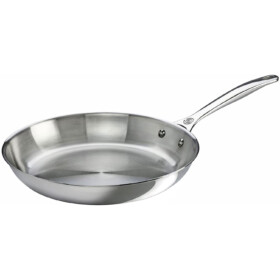
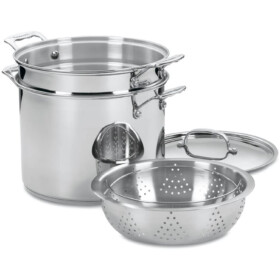
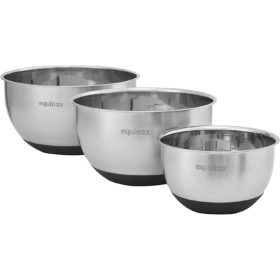
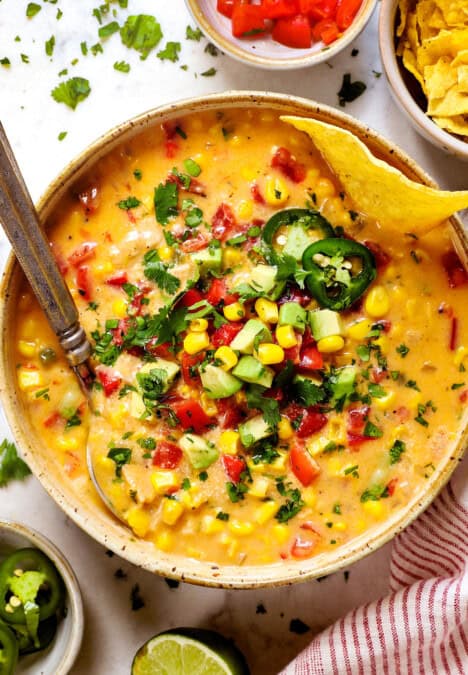
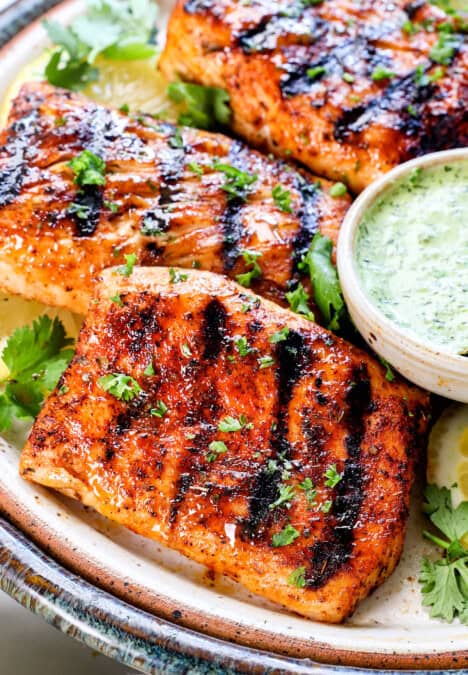
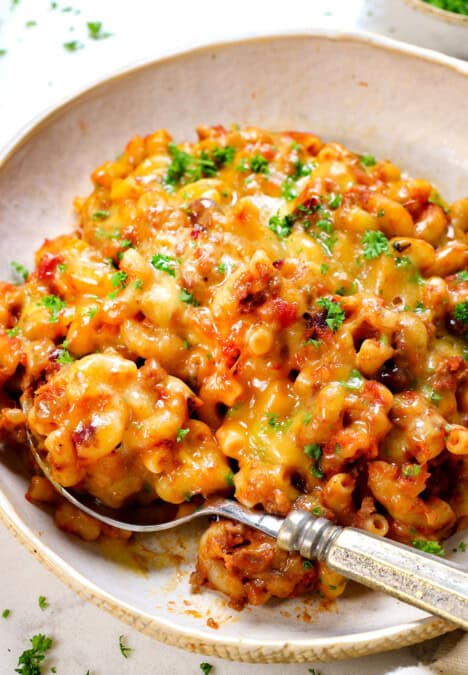
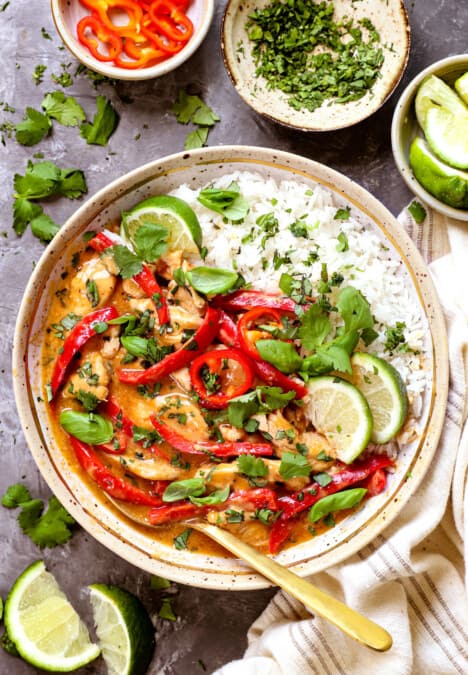
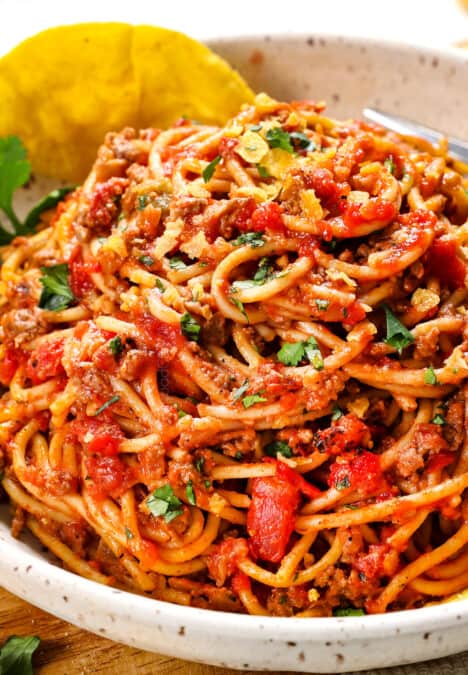
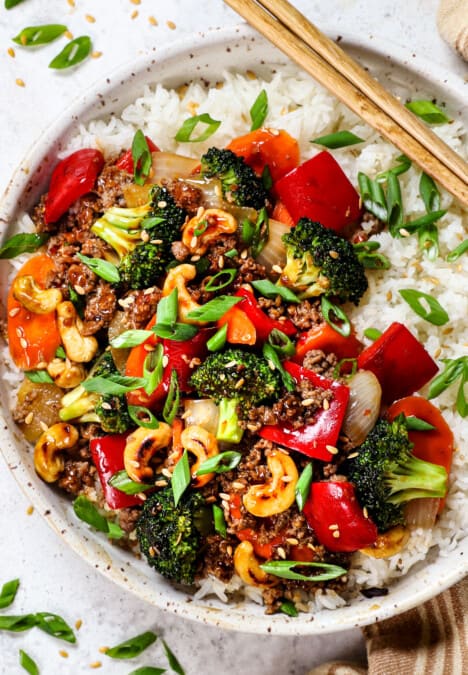


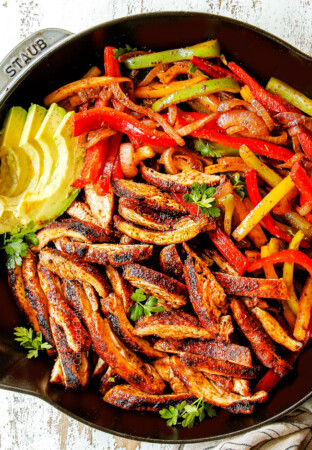
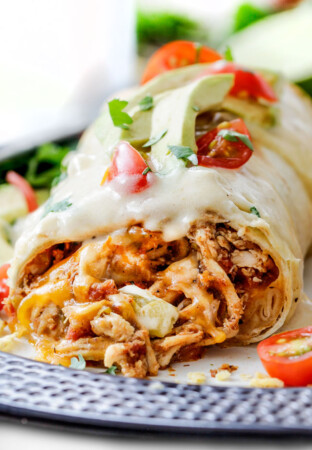
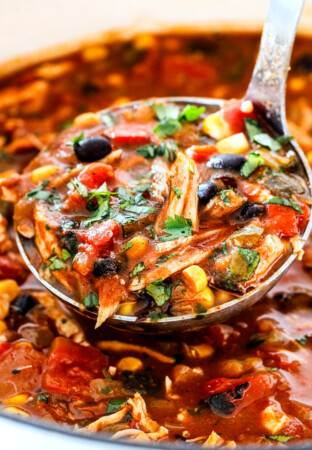
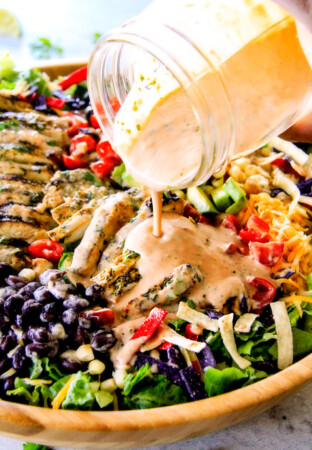
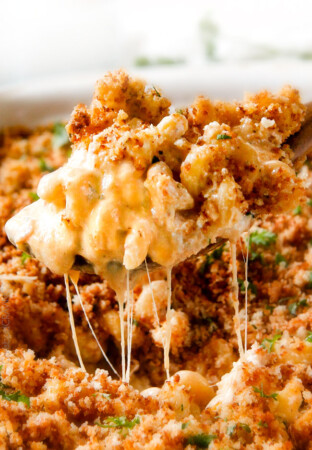
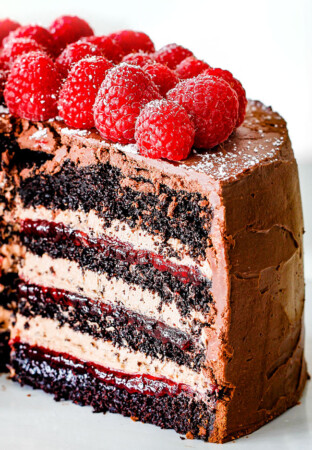
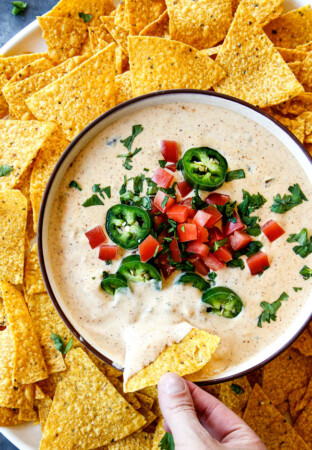
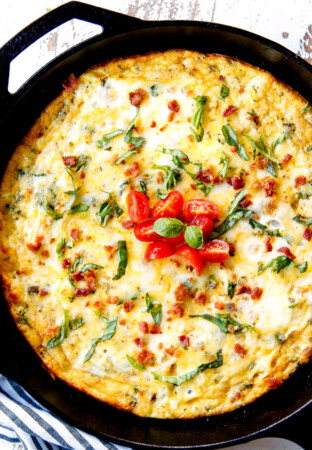
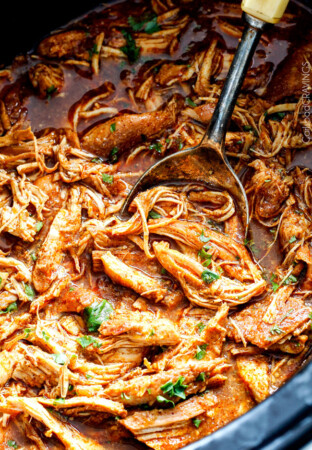
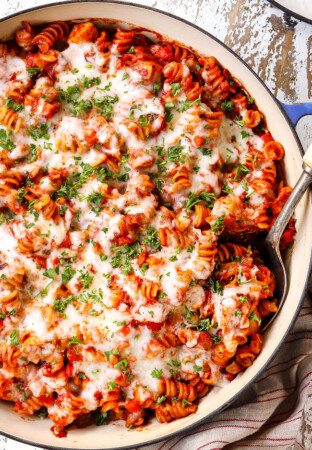
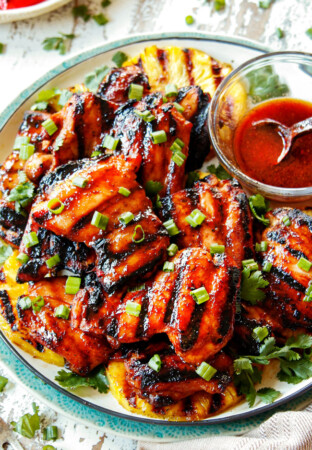
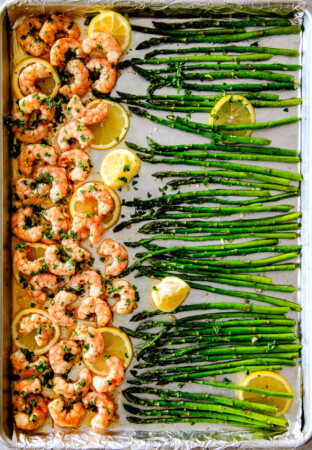
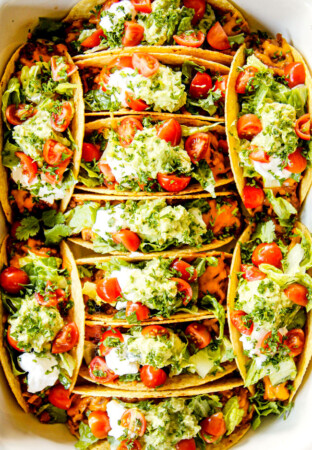
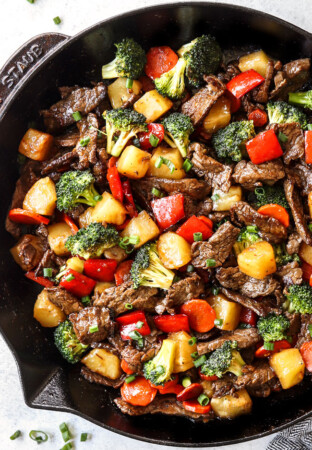
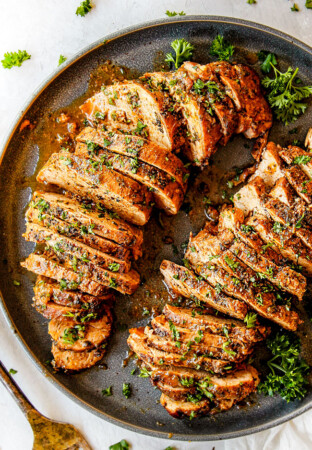
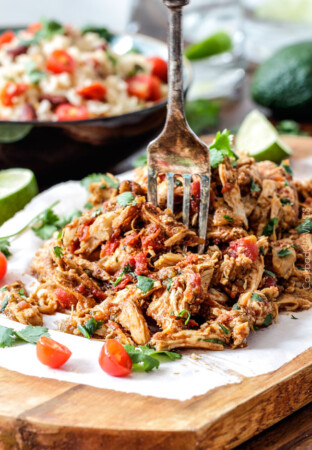
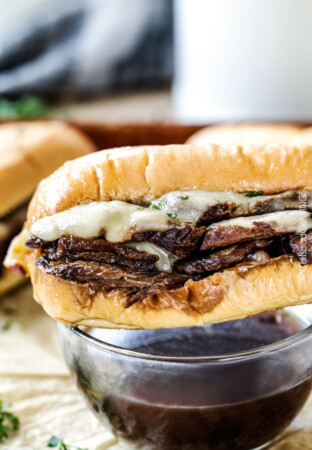
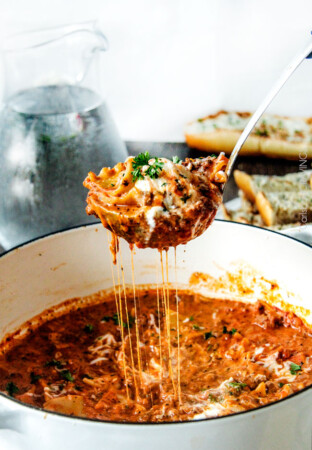
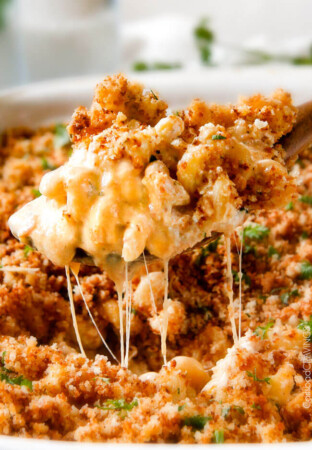
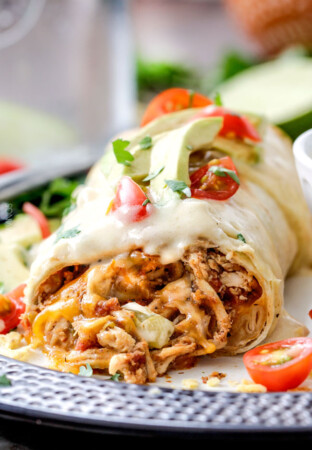
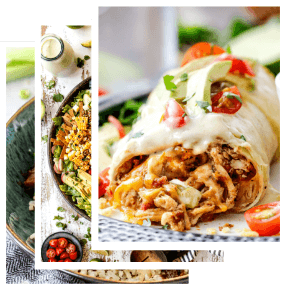
Vinnie says
Wow , You rang the Proverbial Bell with this one ! An almost complete course in Asian Cooking in one recipe ! We had a Stir Fry dinner last night and I velveted the Chicken thighs even though they didn’t need it an we ate heartily ,the red Peppers ,Mushrooms,Celery,Scallions Onions and Garlic in Hoisin sauce over Rice ! Yum, I will definitely have to try your Yakisoba dish it looks terrific ! Thanks for Sharing Jen !
Jen says
You’re so welcome Vinnie! I hope it becomes a new favorite! Your stir fry dinner sounds fabulous!
Laura says
WOW! thank you so much for this, it is awesome. The information you provided is the best I’ve come across. I finally feel confident enough to make this type of dish. AAA+++
Jen says
Thanks so much Laura!
Megan Stevens says
What is a good sub for ginger? I live in the middle of no where and can only go to Walmart. Ginger root is hard to come by, and I would love to make some of these Asian dishes sometime. We can get ginger powder or ginger paste, but that’s it. These look delicious!
Jen says
Hi Megan, you can absolutely substitute with ginger powder/ground ginger. You will need 3X less ground ginger than fresh.
Pam says
Just came back from Kona where we had a dish similar to this. Thought I would give it a try last night and wow! No leftovers .
Jen says
Thank you so much, Pam! I am thrilled this was such a hit!